Transformational Leadership in Nursing Study
VerifiedAdded on 2020/04/15
|13
|3813
|142
AI Summary
Contribute Materials
Your contribution can guide someone’s learning journey. Share your
documents today.
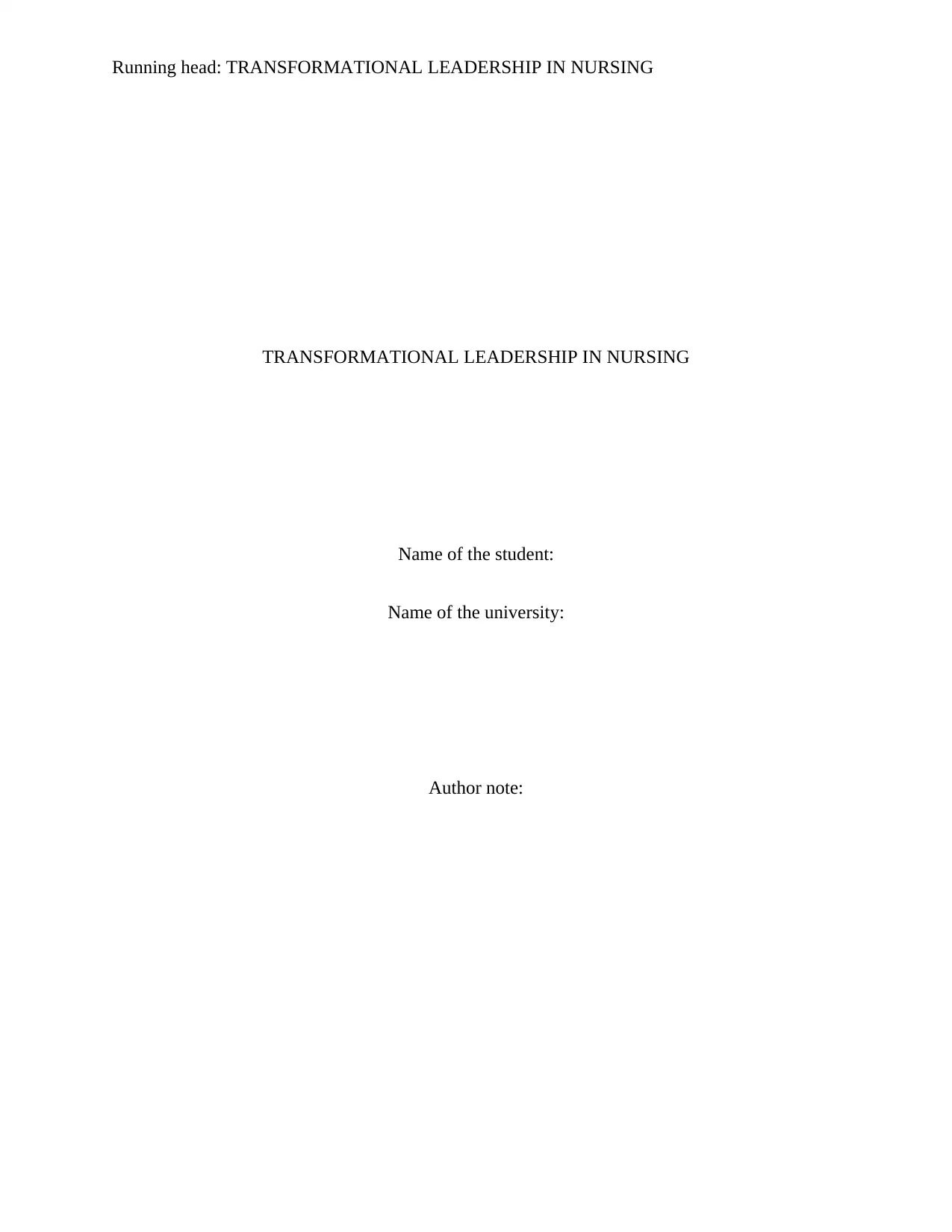
Running head: TRANSFORMATIONAL LEADERSHIP IN NURSING
TRANSFORMATIONAL LEADERSHIP IN NURSING
Name of the student:
Name of the university:
Author note:
TRANSFORMATIONAL LEADERSHIP IN NURSING
Name of the student:
Name of the university:
Author note:
Secure Best Marks with AI Grader
Need help grading? Try our AI Grader for instant feedback on your assignments.
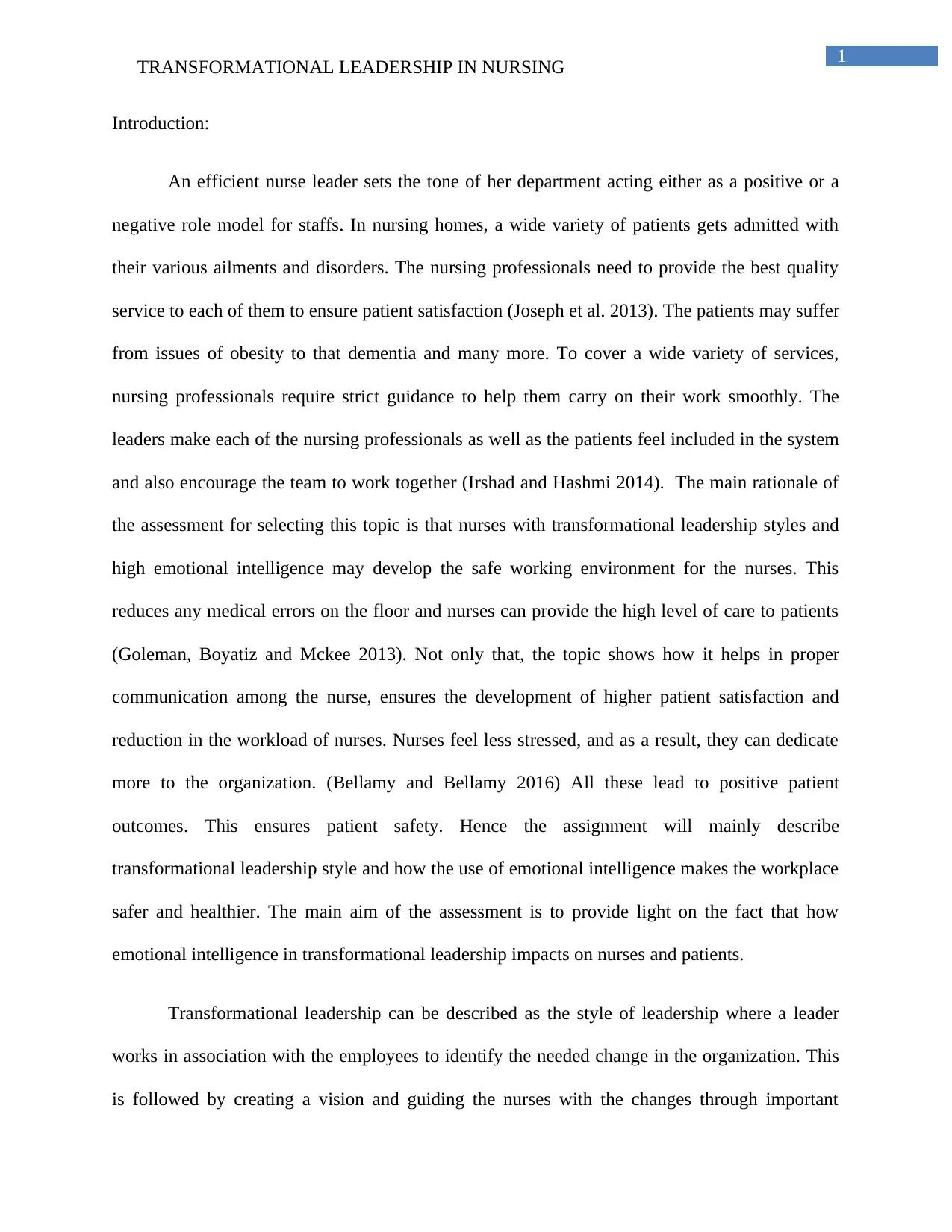
1
TRANSFORMATIONAL LEADERSHIP IN NURSING
Introduction:
An efficient nurse leader sets the tone of her department acting either as a positive or a
negative role model for staffs. In nursing homes, a wide variety of patients gets admitted with
their various ailments and disorders. The nursing professionals need to provide the best quality
service to each of them to ensure patient satisfaction (Joseph et al. 2013). The patients may suffer
from issues of obesity to that dementia and many more. To cover a wide variety of services,
nursing professionals require strict guidance to help them carry on their work smoothly. The
leaders make each of the nursing professionals as well as the patients feel included in the system
and also encourage the team to work together (Irshad and Hashmi 2014). The main rationale of
the assessment for selecting this topic is that nurses with transformational leadership styles and
high emotional intelligence may develop the safe working environment for the nurses. This
reduces any medical errors on the floor and nurses can provide the high level of care to patients
(Goleman, Boyatiz and Mckee 2013). Not only that, the topic shows how it helps in proper
communication among the nurse, ensures the development of higher patient satisfaction and
reduction in the workload of nurses. Nurses feel less stressed, and as a result, they can dedicate
more to the organization. (Bellamy and Bellamy 2016) All these lead to positive patient
outcomes. This ensures patient safety. Hence the assignment will mainly describe
transformational leadership style and how the use of emotional intelligence makes the workplace
safer and healthier. The main aim of the assessment is to provide light on the fact that how
emotional intelligence in transformational leadership impacts on nurses and patients.
Transformational leadership can be described as the style of leadership where a leader
works in association with the employees to identify the needed change in the organization. This
is followed by creating a vision and guiding the nurses with the changes through important
TRANSFORMATIONAL LEADERSHIP IN NURSING
Introduction:
An efficient nurse leader sets the tone of her department acting either as a positive or a
negative role model for staffs. In nursing homes, a wide variety of patients gets admitted with
their various ailments and disorders. The nursing professionals need to provide the best quality
service to each of them to ensure patient satisfaction (Joseph et al. 2013). The patients may suffer
from issues of obesity to that dementia and many more. To cover a wide variety of services,
nursing professionals require strict guidance to help them carry on their work smoothly. The
leaders make each of the nursing professionals as well as the patients feel included in the system
and also encourage the team to work together (Irshad and Hashmi 2014). The main rationale of
the assessment for selecting this topic is that nurses with transformational leadership styles and
high emotional intelligence may develop the safe working environment for the nurses. This
reduces any medical errors on the floor and nurses can provide the high level of care to patients
(Goleman, Boyatiz and Mckee 2013). Not only that, the topic shows how it helps in proper
communication among the nurse, ensures the development of higher patient satisfaction and
reduction in the workload of nurses. Nurses feel less stressed, and as a result, they can dedicate
more to the organization. (Bellamy and Bellamy 2016) All these lead to positive patient
outcomes. This ensures patient safety. Hence the assignment will mainly describe
transformational leadership style and how the use of emotional intelligence makes the workplace
safer and healthier. The main aim of the assessment is to provide light on the fact that how
emotional intelligence in transformational leadership impacts on nurses and patients.
Transformational leadership can be described as the style of leadership where a leader
works in association with the employees to identify the needed change in the organization. This
is followed by creating a vision and guiding the nurses with the changes through important
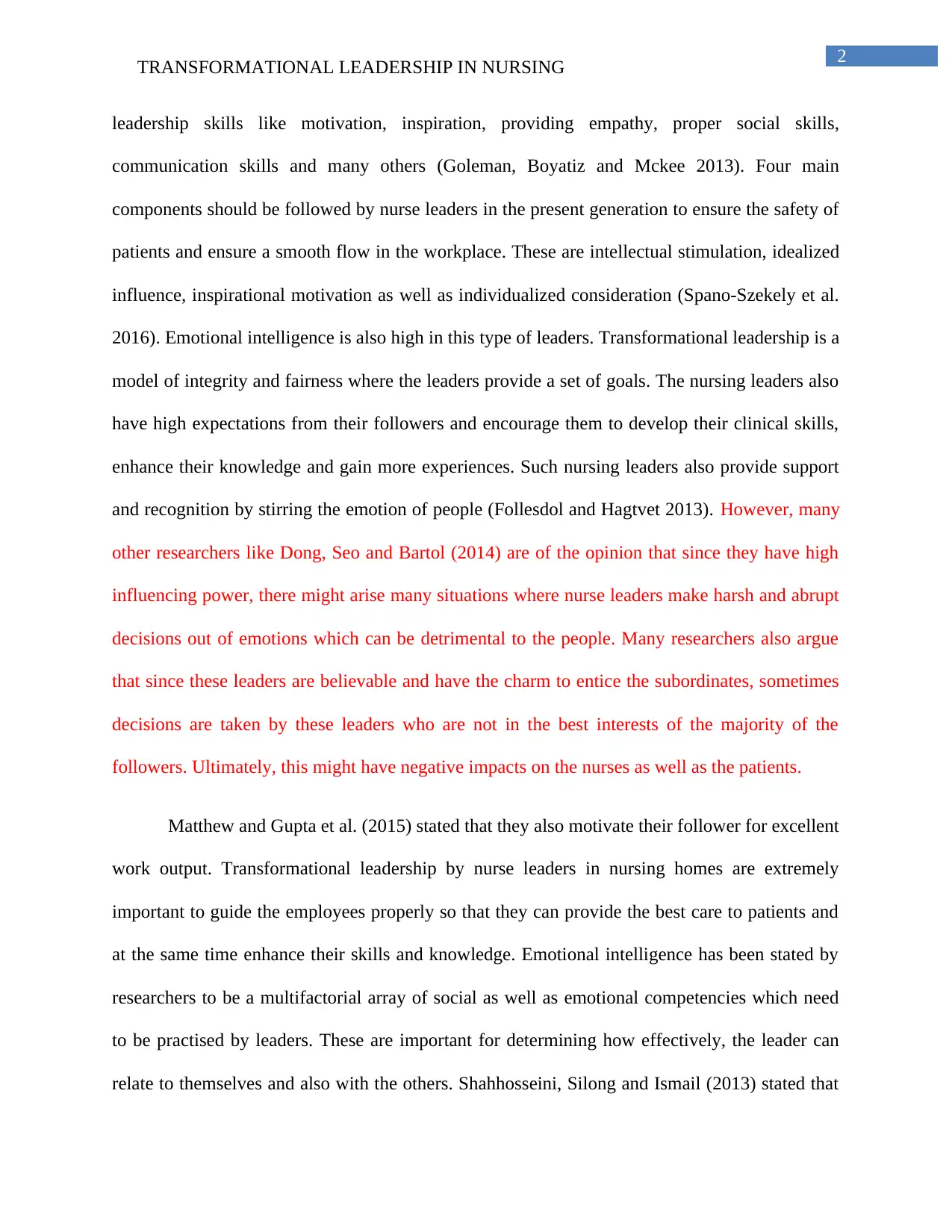
2
TRANSFORMATIONAL LEADERSHIP IN NURSING
leadership skills like motivation, inspiration, providing empathy, proper social skills,
communication skills and many others (Goleman, Boyatiz and Mckee 2013). Four main
components should be followed by nurse leaders in the present generation to ensure the safety of
patients and ensure a smooth flow in the workplace. These are intellectual stimulation, idealized
influence, inspirational motivation as well as individualized consideration (Spano-Szekely et al.
2016). Emotional intelligence is also high in this type of leaders. Transformational leadership is a
model of integrity and fairness where the leaders provide a set of goals. The nursing leaders also
have high expectations from their followers and encourage them to develop their clinical skills,
enhance their knowledge and gain more experiences. Such nursing leaders also provide support
and recognition by stirring the emotion of people (Follesdol and Hagtvet 2013). However, many
other researchers like Dong, Seo and Bartol (2014) are of the opinion that since they have high
influencing power, there might arise many situations where nurse leaders make harsh and abrupt
decisions out of emotions which can be detrimental to the people. Many researchers also argue
that since these leaders are believable and have the charm to entice the subordinates, sometimes
decisions are taken by these leaders who are not in the best interests of the majority of the
followers. Ultimately, this might have negative impacts on the nurses as well as the patients.
Matthew and Gupta et al. (2015) stated that they also motivate their follower for excellent
work output. Transformational leadership by nurse leaders in nursing homes are extremely
important to guide the employees properly so that they can provide the best care to patients and
at the same time enhance their skills and knowledge. Emotional intelligence has been stated by
researchers to be a multifactorial array of social as well as emotional competencies which need
to be practised by leaders. These are important for determining how effectively, the leader can
relate to themselves and also with the others. Shahhosseini, Silong and Ismail (2013) stated that
TRANSFORMATIONAL LEADERSHIP IN NURSING
leadership skills like motivation, inspiration, providing empathy, proper social skills,
communication skills and many others (Goleman, Boyatiz and Mckee 2013). Four main
components should be followed by nurse leaders in the present generation to ensure the safety of
patients and ensure a smooth flow in the workplace. These are intellectual stimulation, idealized
influence, inspirational motivation as well as individualized consideration (Spano-Szekely et al.
2016). Emotional intelligence is also high in this type of leaders. Transformational leadership is a
model of integrity and fairness where the leaders provide a set of goals. The nursing leaders also
have high expectations from their followers and encourage them to develop their clinical skills,
enhance their knowledge and gain more experiences. Such nursing leaders also provide support
and recognition by stirring the emotion of people (Follesdol and Hagtvet 2013). However, many
other researchers like Dong, Seo and Bartol (2014) are of the opinion that since they have high
influencing power, there might arise many situations where nurse leaders make harsh and abrupt
decisions out of emotions which can be detrimental to the people. Many researchers also argue
that since these leaders are believable and have the charm to entice the subordinates, sometimes
decisions are taken by these leaders who are not in the best interests of the majority of the
followers. Ultimately, this might have negative impacts on the nurses as well as the patients.
Matthew and Gupta et al. (2015) stated that they also motivate their follower for excellent
work output. Transformational leadership by nurse leaders in nursing homes are extremely
important to guide the employees properly so that they can provide the best care to patients and
at the same time enhance their skills and knowledge. Emotional intelligence has been stated by
researchers to be a multifactorial array of social as well as emotional competencies which need
to be practised by leaders. These are important for determining how effectively, the leader can
relate to themselves and also with the others. Shahhosseini, Silong and Ismail (2013) stated that
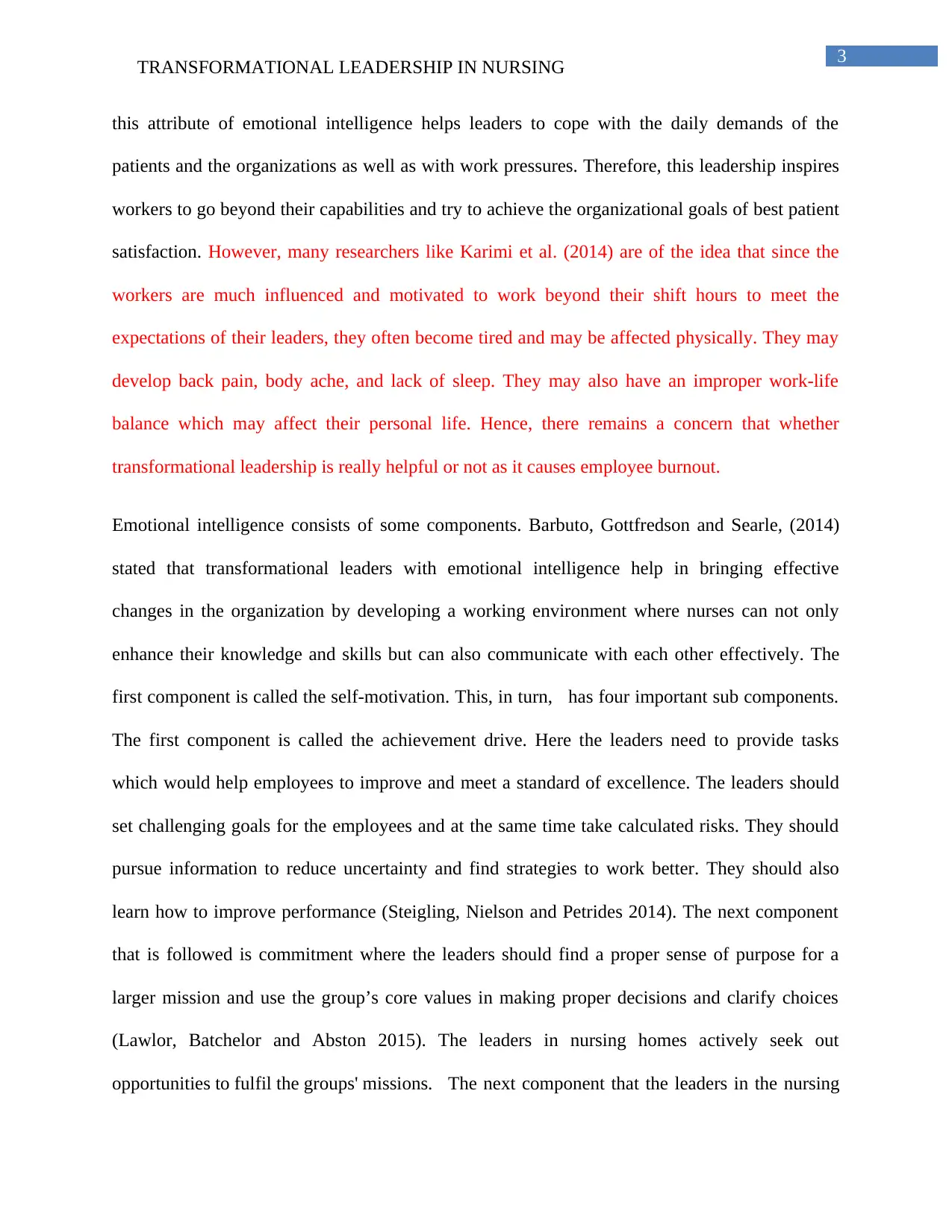
3
TRANSFORMATIONAL LEADERSHIP IN NURSING
this attribute of emotional intelligence helps leaders to cope with the daily demands of the
patients and the organizations as well as with work pressures. Therefore, this leadership inspires
workers to go beyond their capabilities and try to achieve the organizational goals of best patient
satisfaction. However, many researchers like Karimi et al. (2014) are of the idea that since the
workers are much influenced and motivated to work beyond their shift hours to meet the
expectations of their leaders, they often become tired and may be affected physically. They may
develop back pain, body ache, and lack of sleep. They may also have an improper work-life
balance which may affect their personal life. Hence, there remains a concern that whether
transformational leadership is really helpful or not as it causes employee burnout.
Emotional intelligence consists of some components. Barbuto, Gottfredson and Searle, (2014)
stated that transformational leaders with emotional intelligence help in bringing effective
changes in the organization by developing a working environment where nurses can not only
enhance their knowledge and skills but can also communicate with each other effectively. The
first component is called the self-motivation. This, in turn, has four important sub components.
The first component is called the achievement drive. Here the leaders need to provide tasks
which would help employees to improve and meet a standard of excellence. The leaders should
set challenging goals for the employees and at the same time take calculated risks. They should
pursue information to reduce uncertainty and find strategies to work better. They should also
learn how to improve performance (Steigling, Nielson and Petrides 2014). The next component
that is followed is commitment where the leaders should find a proper sense of purpose for a
larger mission and use the group’s core values in making proper decisions and clarify choices
(Lawlor, Batchelor and Abston 2015). The leaders in nursing homes actively seek out
opportunities to fulfil the groups' missions. The next component that the leaders in the nursing
TRANSFORMATIONAL LEADERSHIP IN NURSING
this attribute of emotional intelligence helps leaders to cope with the daily demands of the
patients and the organizations as well as with work pressures. Therefore, this leadership inspires
workers to go beyond their capabilities and try to achieve the organizational goals of best patient
satisfaction. However, many researchers like Karimi et al. (2014) are of the idea that since the
workers are much influenced and motivated to work beyond their shift hours to meet the
expectations of their leaders, they often become tired and may be affected physically. They may
develop back pain, body ache, and lack of sleep. They may also have an improper work-life
balance which may affect their personal life. Hence, there remains a concern that whether
transformational leadership is really helpful or not as it causes employee burnout.
Emotional intelligence consists of some components. Barbuto, Gottfredson and Searle, (2014)
stated that transformational leaders with emotional intelligence help in bringing effective
changes in the organization by developing a working environment where nurses can not only
enhance their knowledge and skills but can also communicate with each other effectively. The
first component is called the self-motivation. This, in turn, has four important sub components.
The first component is called the achievement drive. Here the leaders need to provide tasks
which would help employees to improve and meet a standard of excellence. The leaders should
set challenging goals for the employees and at the same time take calculated risks. They should
pursue information to reduce uncertainty and find strategies to work better. They should also
learn how to improve performance (Steigling, Nielson and Petrides 2014). The next component
that is followed is commitment where the leaders should find a proper sense of purpose for a
larger mission and use the group’s core values in making proper decisions and clarify choices
(Lawlor, Batchelor and Abston 2015). The leaders in nursing homes actively seek out
opportunities to fulfil the groups' missions. The next component that the leaders in the nursing
Secure Best Marks with AI Grader
Need help grading? Try our AI Grader for instant feedback on your assignments.
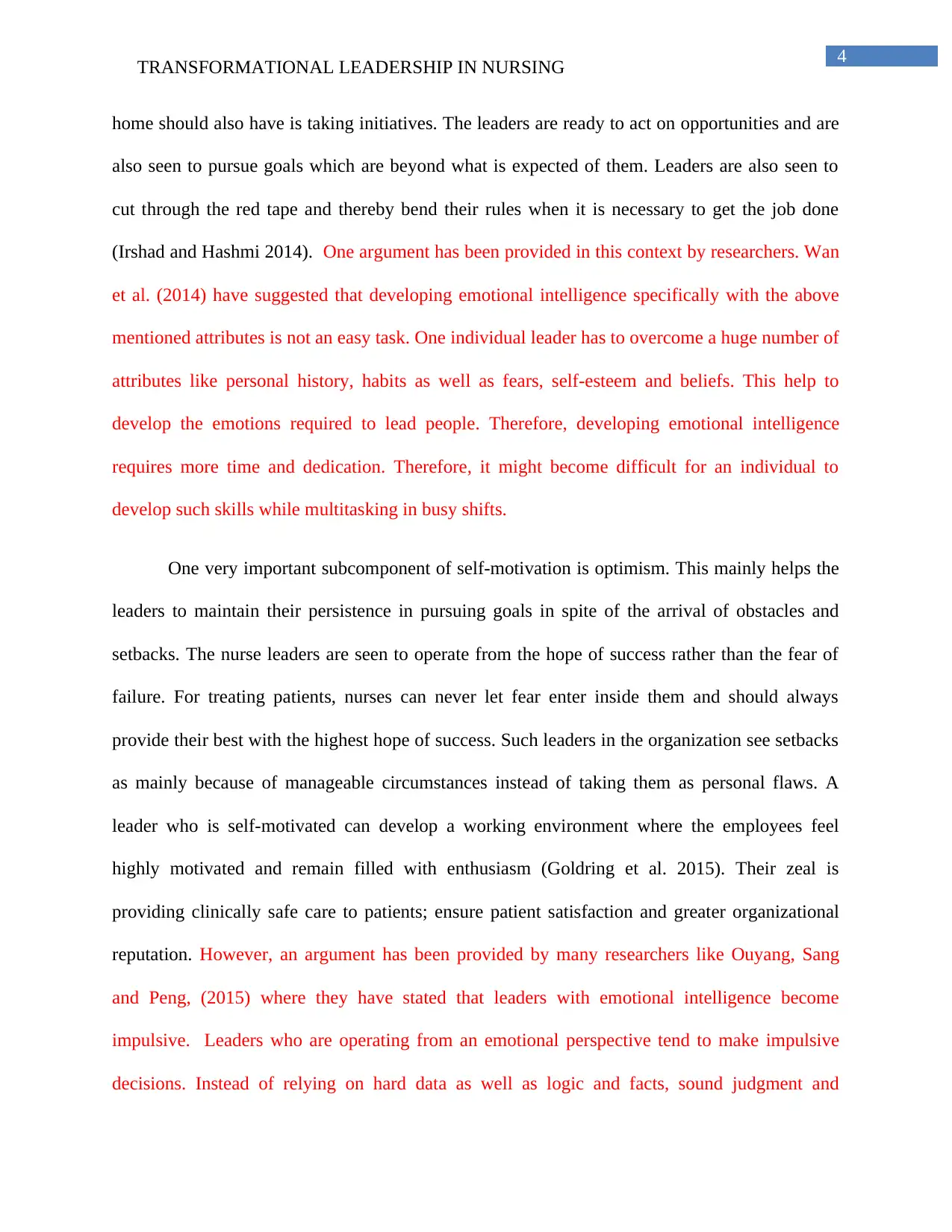
4
TRANSFORMATIONAL LEADERSHIP IN NURSING
home should also have is taking initiatives. The leaders are ready to act on opportunities and are
also seen to pursue goals which are beyond what is expected of them. Leaders are also seen to
cut through the red tape and thereby bend their rules when it is necessary to get the job done
(Irshad and Hashmi 2014). One argument has been provided in this context by researchers. Wan
et al. (2014) have suggested that developing emotional intelligence specifically with the above
mentioned attributes is not an easy task. One individual leader has to overcome a huge number of
attributes like personal history, habits as well as fears, self-esteem and beliefs. This help to
develop the emotions required to lead people. Therefore, developing emotional intelligence
requires more time and dedication. Therefore, it might become difficult for an individual to
develop such skills while multitasking in busy shifts.
One very important subcomponent of self-motivation is optimism. This mainly helps the
leaders to maintain their persistence in pursuing goals in spite of the arrival of obstacles and
setbacks. The nurse leaders are seen to operate from the hope of success rather than the fear of
failure. For treating patients, nurses can never let fear enter inside them and should always
provide their best with the highest hope of success. Such leaders in the organization see setbacks
as mainly because of manageable circumstances instead of taking them as personal flaws. A
leader who is self-motivated can develop a working environment where the employees feel
highly motivated and remain filled with enthusiasm (Goldring et al. 2015). Their zeal is
providing clinically safe care to patients; ensure patient satisfaction and greater organizational
reputation. However, an argument has been provided by many researchers like Ouyang, Sang
and Peng, (2015) where they have stated that leaders with emotional intelligence become
impulsive. Leaders who are operating from an emotional perspective tend to make impulsive
decisions. Instead of relying on hard data as well as logic and facts, sound judgment and
TRANSFORMATIONAL LEADERSHIP IN NURSING
home should also have is taking initiatives. The leaders are ready to act on opportunities and are
also seen to pursue goals which are beyond what is expected of them. Leaders are also seen to
cut through the red tape and thereby bend their rules when it is necessary to get the job done
(Irshad and Hashmi 2014). One argument has been provided in this context by researchers. Wan
et al. (2014) have suggested that developing emotional intelligence specifically with the above
mentioned attributes is not an easy task. One individual leader has to overcome a huge number of
attributes like personal history, habits as well as fears, self-esteem and beliefs. This help to
develop the emotions required to lead people. Therefore, developing emotional intelligence
requires more time and dedication. Therefore, it might become difficult for an individual to
develop such skills while multitasking in busy shifts.
One very important subcomponent of self-motivation is optimism. This mainly helps the
leaders to maintain their persistence in pursuing goals in spite of the arrival of obstacles and
setbacks. The nurse leaders are seen to operate from the hope of success rather than the fear of
failure. For treating patients, nurses can never let fear enter inside them and should always
provide their best with the highest hope of success. Such leaders in the organization see setbacks
as mainly because of manageable circumstances instead of taking them as personal flaws. A
leader who is self-motivated can develop a working environment where the employees feel
highly motivated and remain filled with enthusiasm (Goldring et al. 2015). Their zeal is
providing clinically safe care to patients; ensure patient satisfaction and greater organizational
reputation. However, an argument has been provided by many researchers like Ouyang, Sang
and Peng, (2015) where they have stated that leaders with emotional intelligence become
impulsive. Leaders who are operating from an emotional perspective tend to make impulsive
decisions. Instead of relying on hard data as well as logic and facts, sound judgment and
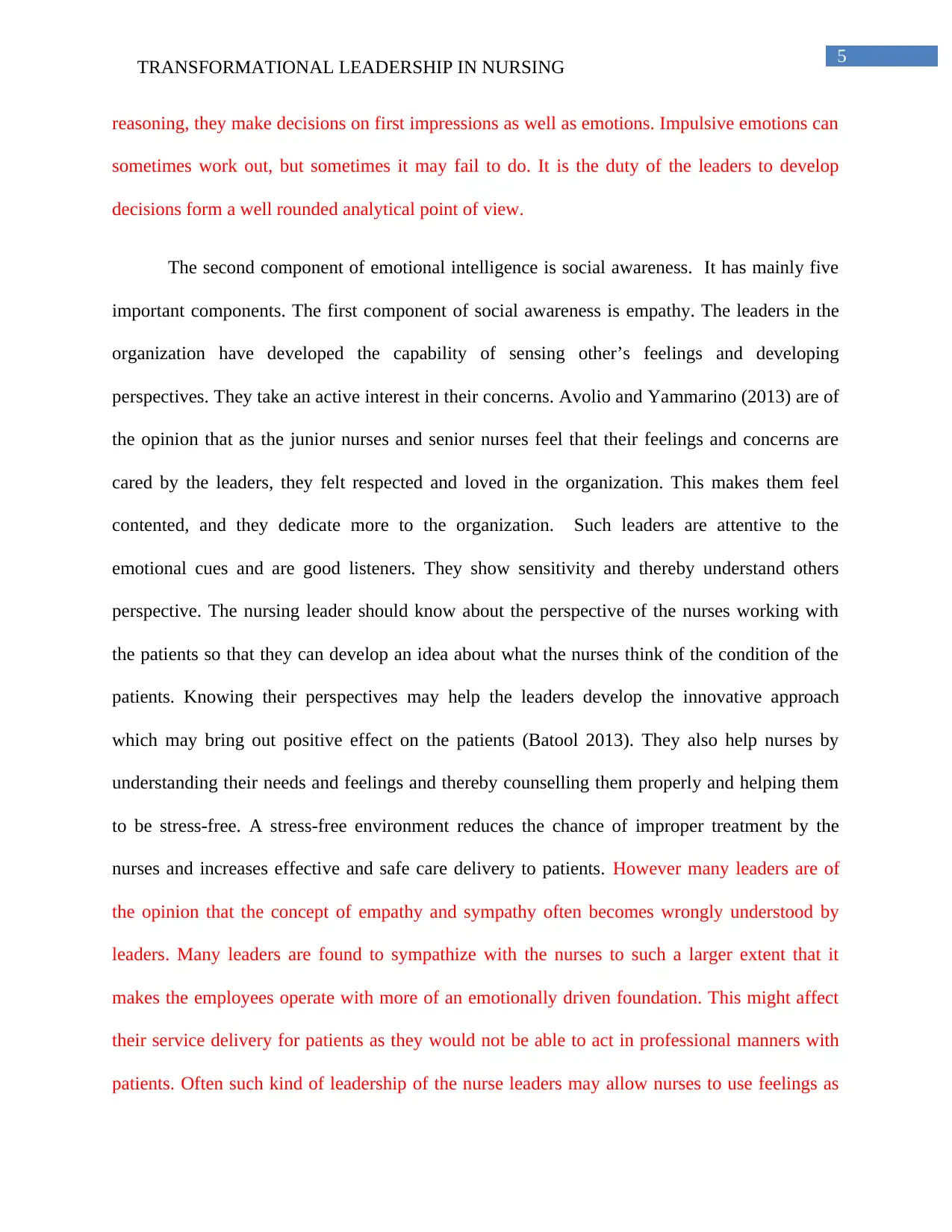
5
TRANSFORMATIONAL LEADERSHIP IN NURSING
reasoning, they make decisions on first impressions as well as emotions. Impulsive emotions can
sometimes work out, but sometimes it may fail to do. It is the duty of the leaders to develop
decisions form a well rounded analytical point of view.
The second component of emotional intelligence is social awareness. It has mainly five
important components. The first component of social awareness is empathy. The leaders in the
organization have developed the capability of sensing other’s feelings and developing
perspectives. They take an active interest in their concerns. Avolio and Yammarino (2013) are of
the opinion that as the junior nurses and senior nurses feel that their feelings and concerns are
cared by the leaders, they felt respected and loved in the organization. This makes them feel
contented, and they dedicate more to the organization. Such leaders are attentive to the
emotional cues and are good listeners. They show sensitivity and thereby understand others
perspective. The nursing leader should know about the perspective of the nurses working with
the patients so that they can develop an idea about what the nurses think of the condition of the
patients. Knowing their perspectives may help the leaders develop the innovative approach
which may bring out positive effect on the patients (Batool 2013). They also help nurses by
understanding their needs and feelings and thereby counselling them properly and helping them
to be stress-free. A stress-free environment reduces the chance of improper treatment by the
nurses and increases effective and safe care delivery to patients. However many leaders are of
the opinion that the concept of empathy and sympathy often becomes wrongly understood by
leaders. Many leaders are found to sympathize with the nurses to such a larger extent that it
makes the employees operate with more of an emotionally driven foundation. This might affect
their service delivery for patients as they would not be able to act in professional manners with
patients. Often such kind of leadership of the nurse leaders may allow nurses to use feelings as
TRANSFORMATIONAL LEADERSHIP IN NURSING
reasoning, they make decisions on first impressions as well as emotions. Impulsive emotions can
sometimes work out, but sometimes it may fail to do. It is the duty of the leaders to develop
decisions form a well rounded analytical point of view.
The second component of emotional intelligence is social awareness. It has mainly five
important components. The first component of social awareness is empathy. The leaders in the
organization have developed the capability of sensing other’s feelings and developing
perspectives. They take an active interest in their concerns. Avolio and Yammarino (2013) are of
the opinion that as the junior nurses and senior nurses feel that their feelings and concerns are
cared by the leaders, they felt respected and loved in the organization. This makes them feel
contented, and they dedicate more to the organization. Such leaders are attentive to the
emotional cues and are good listeners. They show sensitivity and thereby understand others
perspective. The nursing leader should know about the perspective of the nurses working with
the patients so that they can develop an idea about what the nurses think of the condition of the
patients. Knowing their perspectives may help the leaders develop the innovative approach
which may bring out positive effect on the patients (Batool 2013). They also help nurses by
understanding their needs and feelings and thereby counselling them properly and helping them
to be stress-free. A stress-free environment reduces the chance of improper treatment by the
nurses and increases effective and safe care delivery to patients. However many leaders are of
the opinion that the concept of empathy and sympathy often becomes wrongly understood by
leaders. Many leaders are found to sympathize with the nurses to such a larger extent that it
makes the employees operate with more of an emotionally driven foundation. This might affect
their service delivery for patients as they would not be able to act in professional manners with
patients. Often such kind of leadership of the nurse leaders may allow nurses to use feelings as

6
TRANSFORMATIONAL LEADERSHIP IN NURSING
well as problems as different excuses for their underperformance in caring for patients or to
avoid any requisite duties. This may result in the conflicted workplace (Garcio et al. 2014).
The second component of social awareness is proper service orientation. Here the leaders help
the nurses to correctly anticipate, recognize and thereby meet needs of the patients. Here the
leaders guide the nurses to understand the patient’s needs and match them to the services or
products (Batool 2013). The nursing leaders encourage the nurses to seek for different ways by
which satisfaction of the patients can be enhanced, and loyalty can be developed. The leaders
mentor the nurses in offering appropriate assistance to the patients. The third component is the
development of others. Researchers stated that the leaders of the nursing homes acknowledge
and thereby reward the strengths of the nurses, their accomplishments and their development.
This makes the nurses feel happier and makes them motivated to work harder. The leaders
thereby provide effective feedback and thereby identify needs of the nurse for development.
However, Gunkel, Schlagel and Engle, (2014) stated that if one looks over the aspects of
emotional intelligence, it can be seen that this attribute may make the leaders quite manipulative.
The leaders by using their skills like empathy, motivation, caring and social skills, they might
make the workers perform many functions which might not belong to their job roles or duties.
These might make them overwork which is unethical in perspective of human rights.
The fourth component is the leveraging diversity where the leaders get the scope of
cultivating opportunities for diverse people. The leaders should himself apply and teach the
nurses about how to respect as well as relate well to the pupil from a variety of backgrounds.
These forms of leaders can understand worldviews and are therefore sensitive to different group
differences. They remain very careful that no cultural conflicts arise as they may hamper patient
care delivery and makes the working environment stressed. (Tyckzkowski et al. 2015). These
TRANSFORMATIONAL LEADERSHIP IN NURSING
well as problems as different excuses for their underperformance in caring for patients or to
avoid any requisite duties. This may result in the conflicted workplace (Garcio et al. 2014).
The second component of social awareness is proper service orientation. Here the leaders help
the nurses to correctly anticipate, recognize and thereby meet needs of the patients. Here the
leaders guide the nurses to understand the patient’s needs and match them to the services or
products (Batool 2013). The nursing leaders encourage the nurses to seek for different ways by
which satisfaction of the patients can be enhanced, and loyalty can be developed. The leaders
mentor the nurses in offering appropriate assistance to the patients. The third component is the
development of others. Researchers stated that the leaders of the nursing homes acknowledge
and thereby reward the strengths of the nurses, their accomplishments and their development.
This makes the nurses feel happier and makes them motivated to work harder. The leaders
thereby provide effective feedback and thereby identify needs of the nurse for development.
However, Gunkel, Schlagel and Engle, (2014) stated that if one looks over the aspects of
emotional intelligence, it can be seen that this attribute may make the leaders quite manipulative.
The leaders by using their skills like empathy, motivation, caring and social skills, they might
make the workers perform many functions which might not belong to their job roles or duties.
These might make them overwork which is unethical in perspective of human rights.
The fourth component is the leveraging diversity where the leaders get the scope of
cultivating opportunities for diverse people. The leaders should himself apply and teach the
nurses about how to respect as well as relate well to the pupil from a variety of backgrounds.
These forms of leaders can understand worldviews and are therefore sensitive to different group
differences. They remain very careful that no cultural conflicts arise as they may hamper patient
care delivery and makes the working environment stressed. (Tyckzkowski et al. 2015). These
Paraphrase This Document
Need a fresh take? Get an instant paraphrase of this document with our AI Paraphraser
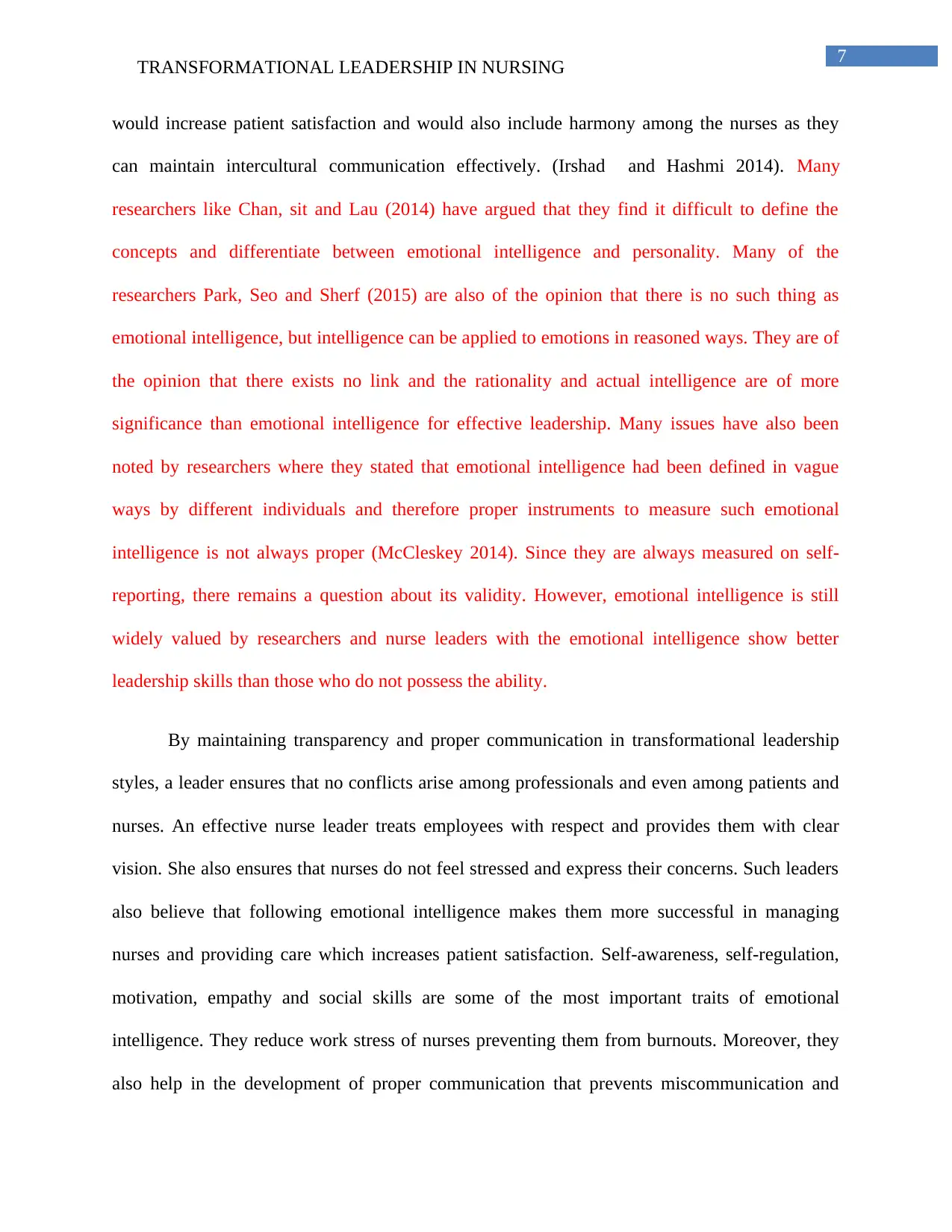
7
TRANSFORMATIONAL LEADERSHIP IN NURSING
would increase patient satisfaction and would also include harmony among the nurses as they
can maintain intercultural communication effectively. (Irshad and Hashmi 2014). Many
researchers like Chan, sit and Lau (2014) have argued that they find it difficult to define the
concepts and differentiate between emotional intelligence and personality. Many of the
researchers Park, Seo and Sherf (2015) are also of the opinion that there is no such thing as
emotional intelligence, but intelligence can be applied to emotions in reasoned ways. They are of
the opinion that there exists no link and the rationality and actual intelligence are of more
significance than emotional intelligence for effective leadership. Many issues have also been
noted by researchers where they stated that emotional intelligence had been defined in vague
ways by different individuals and therefore proper instruments to measure such emotional
intelligence is not always proper (McCleskey 2014). Since they are always measured on self-
reporting, there remains a question about its validity. However, emotional intelligence is still
widely valued by researchers and nurse leaders with the emotional intelligence show better
leadership skills than those who do not possess the ability.
By maintaining transparency and proper communication in transformational leadership
styles, a leader ensures that no conflicts arise among professionals and even among patients and
nurses. An effective nurse leader treats employees with respect and provides them with clear
vision. She also ensures that nurses do not feel stressed and express their concerns. Such leaders
also believe that following emotional intelligence makes them more successful in managing
nurses and providing care which increases patient satisfaction. Self-awareness, self-regulation,
motivation, empathy and social skills are some of the most important traits of emotional
intelligence. They reduce work stress of nurses preventing them from burnouts. Moreover, they
also help in the development of proper communication that prevents miscommunication and
TRANSFORMATIONAL LEADERSHIP IN NURSING
would increase patient satisfaction and would also include harmony among the nurses as they
can maintain intercultural communication effectively. (Irshad and Hashmi 2014). Many
researchers like Chan, sit and Lau (2014) have argued that they find it difficult to define the
concepts and differentiate between emotional intelligence and personality. Many of the
researchers Park, Seo and Sherf (2015) are also of the opinion that there is no such thing as
emotional intelligence, but intelligence can be applied to emotions in reasoned ways. They are of
the opinion that there exists no link and the rationality and actual intelligence are of more
significance than emotional intelligence for effective leadership. Many issues have also been
noted by researchers where they stated that emotional intelligence had been defined in vague
ways by different individuals and therefore proper instruments to measure such emotional
intelligence is not always proper (McCleskey 2014). Since they are always measured on self-
reporting, there remains a question about its validity. However, emotional intelligence is still
widely valued by researchers and nurse leaders with the emotional intelligence show better
leadership skills than those who do not possess the ability.
By maintaining transparency and proper communication in transformational leadership
styles, a leader ensures that no conflicts arise among professionals and even among patients and
nurses. An effective nurse leader treats employees with respect and provides them with clear
vision. She also ensures that nurses do not feel stressed and express their concerns. Such leaders
also believe that following emotional intelligence makes them more successful in managing
nurses and providing care which increases patient satisfaction. Self-awareness, self-regulation,
motivation, empathy and social skills are some of the most important traits of emotional
intelligence. They reduce work stress of nurses preventing them from burnouts. Moreover, they
also help in the development of proper communication that prevents miscommunication and
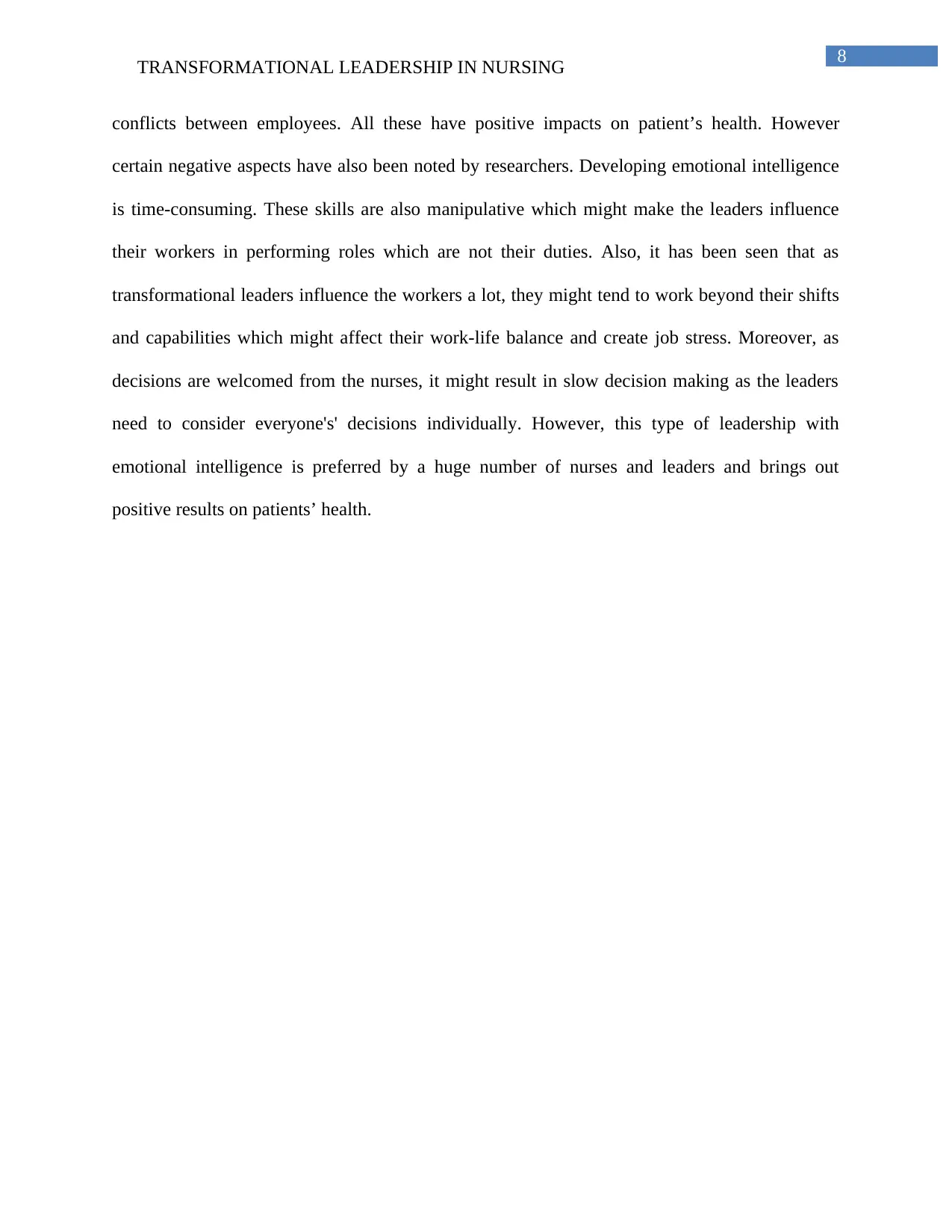
8
TRANSFORMATIONAL LEADERSHIP IN NURSING
conflicts between employees. All these have positive impacts on patient’s health. However
certain negative aspects have also been noted by researchers. Developing emotional intelligence
is time-consuming. These skills are also manipulative which might make the leaders influence
their workers in performing roles which are not their duties. Also, it has been seen that as
transformational leaders influence the workers a lot, they might tend to work beyond their shifts
and capabilities which might affect their work-life balance and create job stress. Moreover, as
decisions are welcomed from the nurses, it might result in slow decision making as the leaders
need to consider everyone's' decisions individually. However, this type of leadership with
emotional intelligence is preferred by a huge number of nurses and leaders and brings out
positive results on patients’ health.
TRANSFORMATIONAL LEADERSHIP IN NURSING
conflicts between employees. All these have positive impacts on patient’s health. However
certain negative aspects have also been noted by researchers. Developing emotional intelligence
is time-consuming. These skills are also manipulative which might make the leaders influence
their workers in performing roles which are not their duties. Also, it has been seen that as
transformational leaders influence the workers a lot, they might tend to work beyond their shifts
and capabilities which might affect their work-life balance and create job stress. Moreover, as
decisions are welcomed from the nurses, it might result in slow decision making as the leaders
need to consider everyone's' decisions individually. However, this type of leadership with
emotional intelligence is preferred by a huge number of nurses and leaders and brings out
positive results on patients’ health.
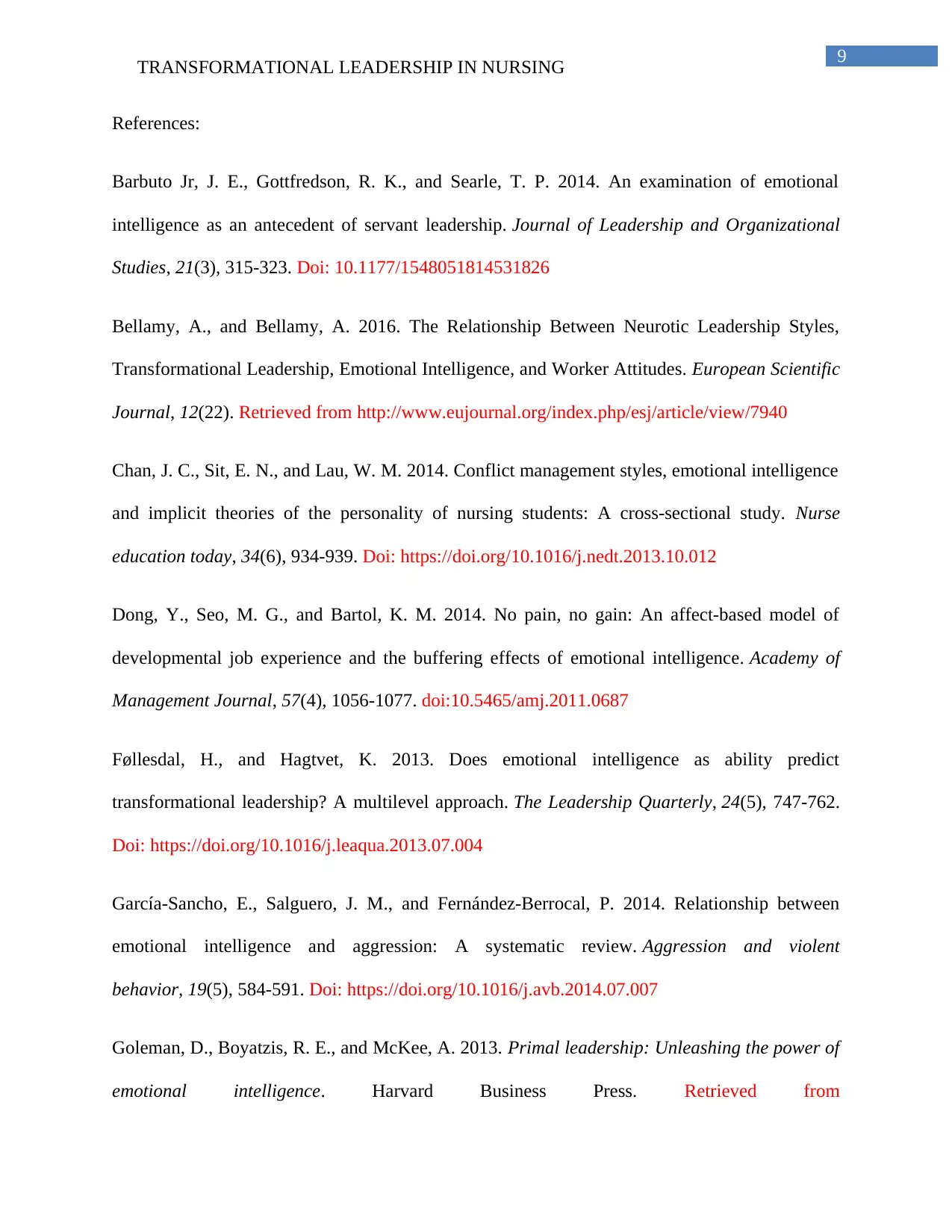
9
TRANSFORMATIONAL LEADERSHIP IN NURSING
References:
Barbuto Jr, J. E., Gottfredson, R. K., and Searle, T. P. 2014. An examination of emotional
intelligence as an antecedent of servant leadership. Journal of Leadership and Organizational
Studies, 21(3), 315-323. Doi: 10.1177/1548051814531826
Bellamy, A., and Bellamy, A. 2016. The Relationship Between Neurotic Leadership Styles,
Transformational Leadership, Emotional Intelligence, and Worker Attitudes. European Scientific
Journal, 12(22). Retrieved from http://www.eujournal.org/index.php/esj/article/view/7940
Chan, J. C., Sit, E. N., and Lau, W. M. 2014. Conflict management styles, emotional intelligence
and implicit theories of the personality of nursing students: A cross-sectional study. Nurse
education today, 34(6), 934-939. Doi: https://doi.org/10.1016/j.nedt.2013.10.012
Dong, Y., Seo, M. G., and Bartol, K. M. 2014. No pain, no gain: An affect-based model of
developmental job experience and the buffering effects of emotional intelligence. Academy of
Management Journal, 57(4), 1056-1077. doi:10.5465/amj.2011.0687
Føllesdal, H., and Hagtvet, K. 2013. Does emotional intelligence as ability predict
transformational leadership? A multilevel approach. The Leadership Quarterly, 24(5), 747-762.
Doi: https://doi.org/10.1016/j.leaqua.2013.07.004
García-Sancho, E., Salguero, J. M., and Fernández-Berrocal, P. 2014. Relationship between
emotional intelligence and aggression: A systematic review. Aggression and violent
behavior, 19(5), 584-591. Doi: https://doi.org/10.1016/j.avb.2014.07.007
Goleman, D., Boyatzis, R. E., and McKee, A. 2013. Primal leadership: Unleashing the power of
emotional intelligence. Harvard Business Press. Retrieved from
TRANSFORMATIONAL LEADERSHIP IN NURSING
References:
Barbuto Jr, J. E., Gottfredson, R. K., and Searle, T. P. 2014. An examination of emotional
intelligence as an antecedent of servant leadership. Journal of Leadership and Organizational
Studies, 21(3), 315-323. Doi: 10.1177/1548051814531826
Bellamy, A., and Bellamy, A. 2016. The Relationship Between Neurotic Leadership Styles,
Transformational Leadership, Emotional Intelligence, and Worker Attitudes. European Scientific
Journal, 12(22). Retrieved from http://www.eujournal.org/index.php/esj/article/view/7940
Chan, J. C., Sit, E. N., and Lau, W. M. 2014. Conflict management styles, emotional intelligence
and implicit theories of the personality of nursing students: A cross-sectional study. Nurse
education today, 34(6), 934-939. Doi: https://doi.org/10.1016/j.nedt.2013.10.012
Dong, Y., Seo, M. G., and Bartol, K. M. 2014. No pain, no gain: An affect-based model of
developmental job experience and the buffering effects of emotional intelligence. Academy of
Management Journal, 57(4), 1056-1077. doi:10.5465/amj.2011.0687
Føllesdal, H., and Hagtvet, K. 2013. Does emotional intelligence as ability predict
transformational leadership? A multilevel approach. The Leadership Quarterly, 24(5), 747-762.
Doi: https://doi.org/10.1016/j.leaqua.2013.07.004
García-Sancho, E., Salguero, J. M., and Fernández-Berrocal, P. 2014. Relationship between
emotional intelligence and aggression: A systematic review. Aggression and violent
behavior, 19(5), 584-591. Doi: https://doi.org/10.1016/j.avb.2014.07.007
Goleman, D., Boyatzis, R. E., and McKee, A. 2013. Primal leadership: Unleashing the power of
emotional intelligence. Harvard Business Press. Retrieved from
Secure Best Marks with AI Grader
Need help grading? Try our AI Grader for instant feedback on your assignments.
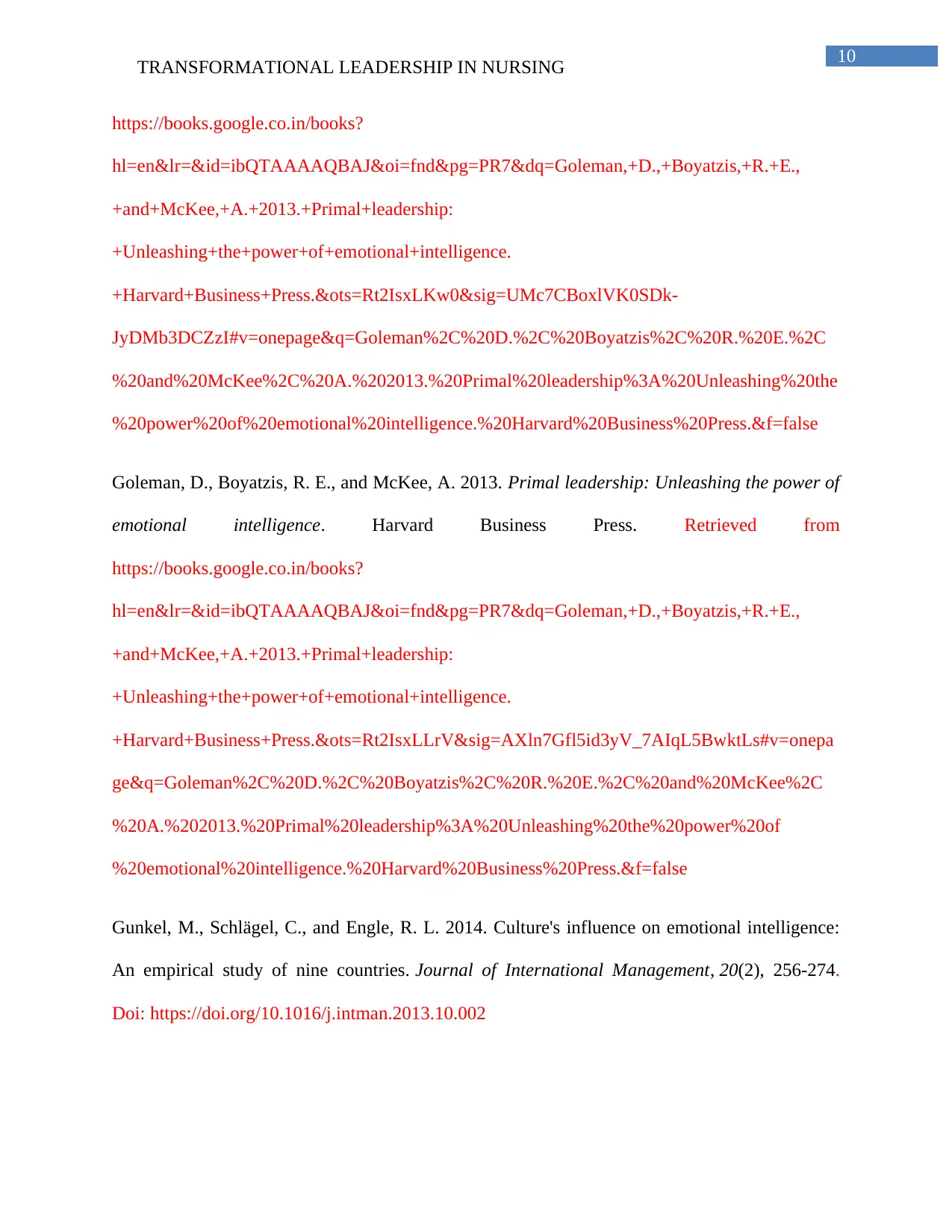
10
TRANSFORMATIONAL LEADERSHIP IN NURSING
https://books.google.co.in/books?
hl=en&lr=&id=ibQTAAAAQBAJ&oi=fnd&pg=PR7&dq=Goleman,+D.,+Boyatzis,+R.+E.,
+and+McKee,+A.+2013.+Primal+leadership:
+Unleashing+the+power+of+emotional+intelligence.
+Harvard+Business+Press.&ots=Rt2IsxLKw0&sig=UMc7CBoxlVK0SDk-
JyDMb3DCZzI#v=onepage&q=Goleman%2C%20D.%2C%20Boyatzis%2C%20R.%20E.%2C
%20and%20McKee%2C%20A.%202013.%20Primal%20leadership%3A%20Unleashing%20the
%20power%20of%20emotional%20intelligence.%20Harvard%20Business%20Press.&f=false
Goleman, D., Boyatzis, R. E., and McKee, A. 2013. Primal leadership: Unleashing the power of
emotional intelligence. Harvard Business Press. Retrieved from
https://books.google.co.in/books?
hl=en&lr=&id=ibQTAAAAQBAJ&oi=fnd&pg=PR7&dq=Goleman,+D.,+Boyatzis,+R.+E.,
+and+McKee,+A.+2013.+Primal+leadership:
+Unleashing+the+power+of+emotional+intelligence.
+Harvard+Business+Press.&ots=Rt2IsxLLrV&sig=AXln7Gfl5id3yV_7AIqL5BwktLs#v=onepa
ge&q=Goleman%2C%20D.%2C%20Boyatzis%2C%20R.%20E.%2C%20and%20McKee%2C
%20A.%202013.%20Primal%20leadership%3A%20Unleashing%20the%20power%20of
%20emotional%20intelligence.%20Harvard%20Business%20Press.&f=false
Gunkel, M., Schlägel, C., and Engle, R. L. 2014. Culture's influence on emotional intelligence:
An empirical study of nine countries. Journal of International Management, 20(2), 256-274.
Doi: https://doi.org/10.1016/j.intman.2013.10.002
TRANSFORMATIONAL LEADERSHIP IN NURSING
https://books.google.co.in/books?
hl=en&lr=&id=ibQTAAAAQBAJ&oi=fnd&pg=PR7&dq=Goleman,+D.,+Boyatzis,+R.+E.,
+and+McKee,+A.+2013.+Primal+leadership:
+Unleashing+the+power+of+emotional+intelligence.
+Harvard+Business+Press.&ots=Rt2IsxLKw0&sig=UMc7CBoxlVK0SDk-
JyDMb3DCZzI#v=onepage&q=Goleman%2C%20D.%2C%20Boyatzis%2C%20R.%20E.%2C
%20and%20McKee%2C%20A.%202013.%20Primal%20leadership%3A%20Unleashing%20the
%20power%20of%20emotional%20intelligence.%20Harvard%20Business%20Press.&f=false
Goleman, D., Boyatzis, R. E., and McKee, A. 2013. Primal leadership: Unleashing the power of
emotional intelligence. Harvard Business Press. Retrieved from
https://books.google.co.in/books?
hl=en&lr=&id=ibQTAAAAQBAJ&oi=fnd&pg=PR7&dq=Goleman,+D.,+Boyatzis,+R.+E.,
+and+McKee,+A.+2013.+Primal+leadership:
+Unleashing+the+power+of+emotional+intelligence.
+Harvard+Business+Press.&ots=Rt2IsxLLrV&sig=AXln7Gfl5id3yV_7AIqL5BwktLs#v=onepa
ge&q=Goleman%2C%20D.%2C%20Boyatzis%2C%20R.%20E.%2C%20and%20McKee%2C
%20A.%202013.%20Primal%20leadership%3A%20Unleashing%20the%20power%20of
%20emotional%20intelligence.%20Harvard%20Business%20Press.&f=false
Gunkel, M., Schlägel, C., and Engle, R. L. 2014. Culture's influence on emotional intelligence:
An empirical study of nine countries. Journal of International Management, 20(2), 256-274.
Doi: https://doi.org/10.1016/j.intman.2013.10.002
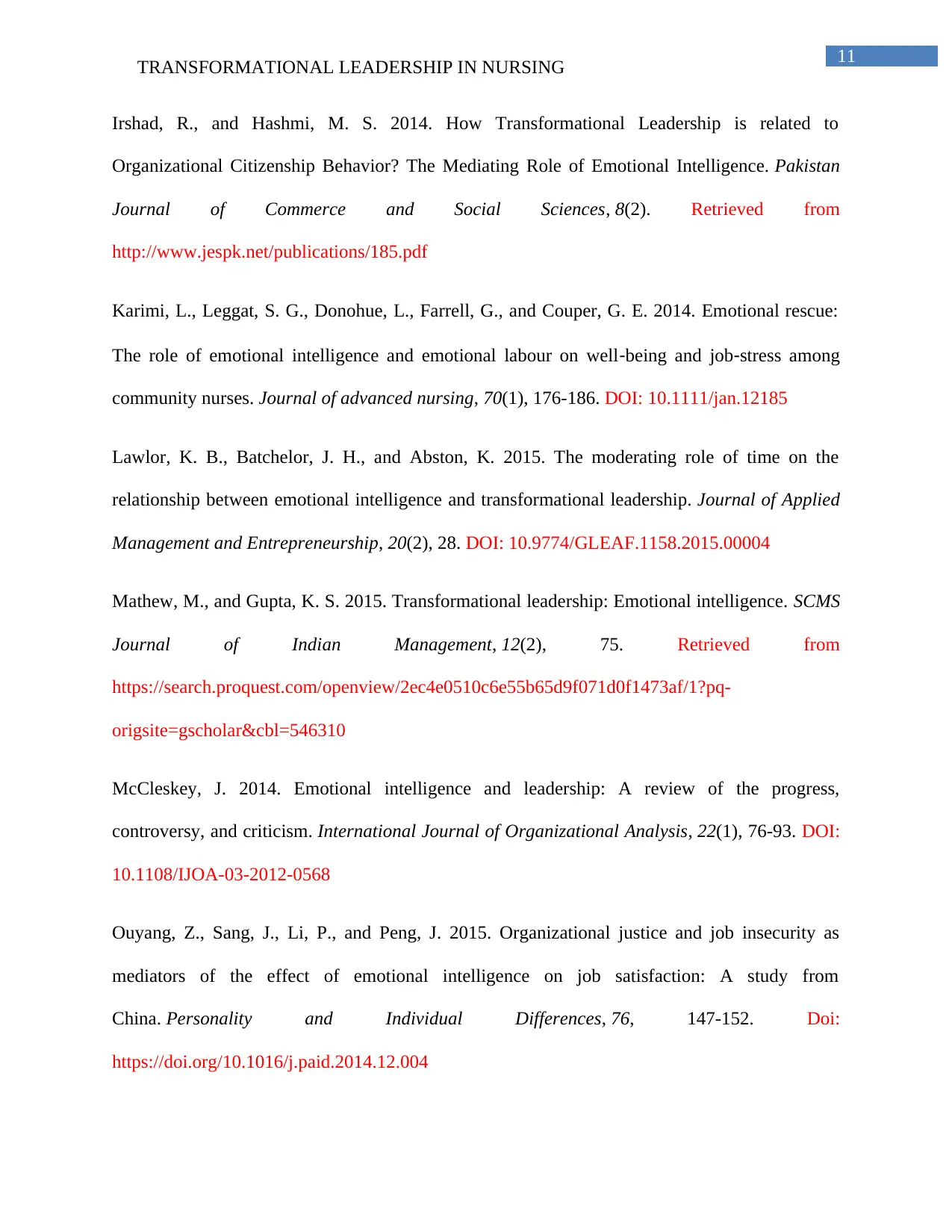
11
TRANSFORMATIONAL LEADERSHIP IN NURSING
Irshad, R., and Hashmi, M. S. 2014. How Transformational Leadership is related to
Organizational Citizenship Behavior? The Mediating Role of Emotional Intelligence. Pakistan
Journal of Commerce and Social Sciences, 8(2). Retrieved from
http://www.jespk.net/publications/185.pdf
Karimi, L., Leggat, S. G., Donohue, L., Farrell, G., and Couper, G. E. 2014. Emotional rescue:
The role of emotional intelligence and emotional labour on well‐being and job‐stress among
community nurses. Journal of advanced nursing, 70(1), 176-186. DOI: 10.1111/jan.12185
Lawlor, K. B., Batchelor, J. H., and Abston, K. 2015. The moderating role of time on the
relationship between emotional intelligence and transformational leadership. Journal of Applied
Management and Entrepreneurship, 20(2), 28. DOI: 10.9774/GLEAF.1158.2015.00004
Mathew, M., and Gupta, K. S. 2015. Transformational leadership: Emotional intelligence. SCMS
Journal of Indian Management, 12(2), 75. Retrieved from
https://search.proquest.com/openview/2ec4e0510c6e55b65d9f071d0f1473af/1?pq-
origsite=gscholar&cbl=546310
McCleskey, J. 2014. Emotional intelligence and leadership: A review of the progress,
controversy, and criticism. International Journal of Organizational Analysis, 22(1), 76-93. DOI:
10.1108/IJOA-03-2012-0568
Ouyang, Z., Sang, J., Li, P., and Peng, J. 2015. Organizational justice and job insecurity as
mediators of the effect of emotional intelligence on job satisfaction: A study from
China. Personality and Individual Differences, 76, 147-152. Doi:
https://doi.org/10.1016/j.paid.2014.12.004
TRANSFORMATIONAL LEADERSHIP IN NURSING
Irshad, R., and Hashmi, M. S. 2014. How Transformational Leadership is related to
Organizational Citizenship Behavior? The Mediating Role of Emotional Intelligence. Pakistan
Journal of Commerce and Social Sciences, 8(2). Retrieved from
http://www.jespk.net/publications/185.pdf
Karimi, L., Leggat, S. G., Donohue, L., Farrell, G., and Couper, G. E. 2014. Emotional rescue:
The role of emotional intelligence and emotional labour on well‐being and job‐stress among
community nurses. Journal of advanced nursing, 70(1), 176-186. DOI: 10.1111/jan.12185
Lawlor, K. B., Batchelor, J. H., and Abston, K. 2015. The moderating role of time on the
relationship between emotional intelligence and transformational leadership. Journal of Applied
Management and Entrepreneurship, 20(2), 28. DOI: 10.9774/GLEAF.1158.2015.00004
Mathew, M., and Gupta, K. S. 2015. Transformational leadership: Emotional intelligence. SCMS
Journal of Indian Management, 12(2), 75. Retrieved from
https://search.proquest.com/openview/2ec4e0510c6e55b65d9f071d0f1473af/1?pq-
origsite=gscholar&cbl=546310
McCleskey, J. 2014. Emotional intelligence and leadership: A review of the progress,
controversy, and criticism. International Journal of Organizational Analysis, 22(1), 76-93. DOI:
10.1108/IJOA-03-2012-0568
Ouyang, Z., Sang, J., Li, P., and Peng, J. 2015. Organizational justice and job insecurity as
mediators of the effect of emotional intelligence on job satisfaction: A study from
China. Personality and Individual Differences, 76, 147-152. Doi:
https://doi.org/10.1016/j.paid.2014.12.004
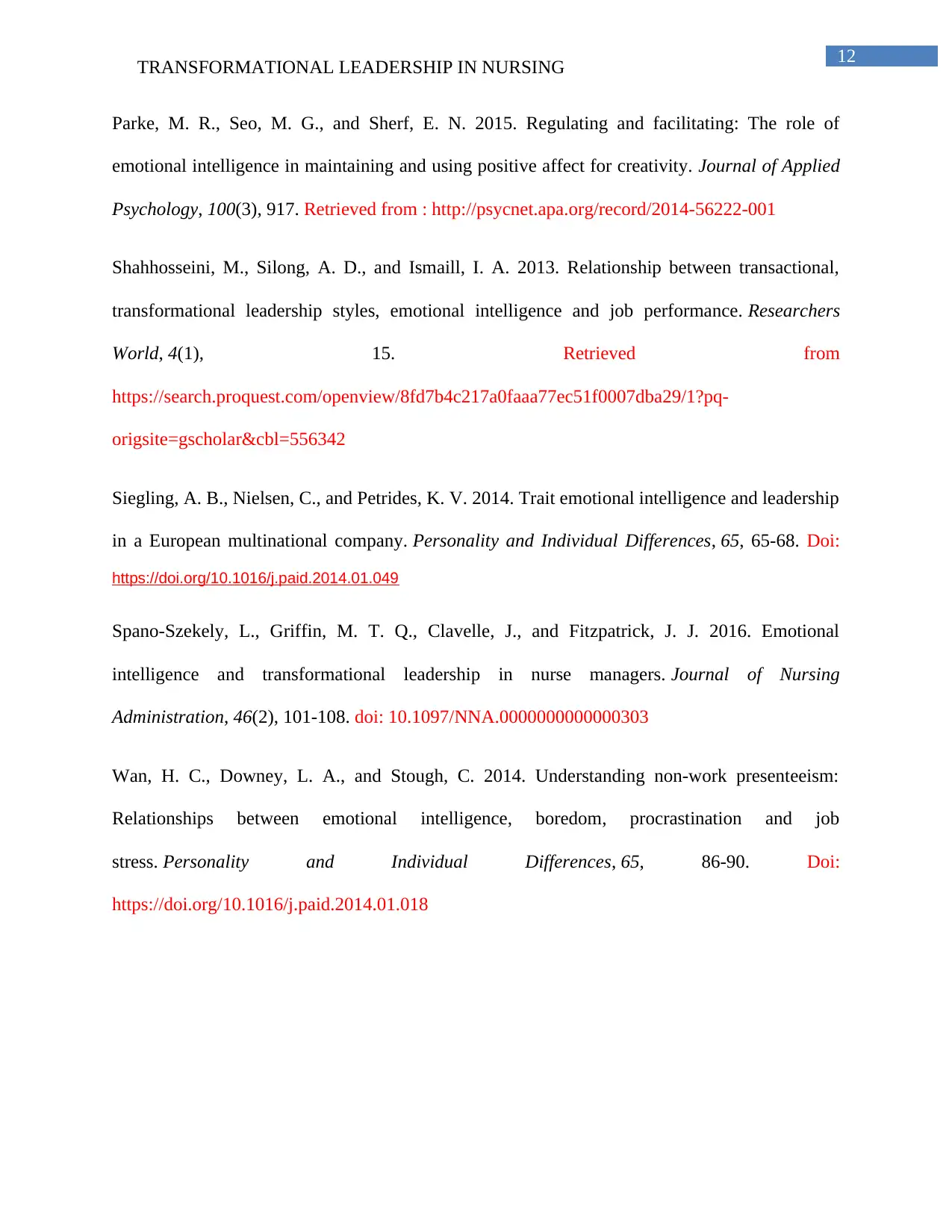
12
TRANSFORMATIONAL LEADERSHIP IN NURSING
Parke, M. R., Seo, M. G., and Sherf, E. N. 2015. Regulating and facilitating: The role of
emotional intelligence in maintaining and using positive affect for creativity. Journal of Applied
Psychology, 100(3), 917. Retrieved from : http://psycnet.apa.org/record/2014-56222-001
Shahhosseini, M., Silong, A. D., and Ismaill, I. A. 2013. Relationship between transactional,
transformational leadership styles, emotional intelligence and job performance. Researchers
World, 4(1), 15. Retrieved from
https://search.proquest.com/openview/8fd7b4c217a0faaa77ec51f0007dba29/1?pq-
origsite=gscholar&cbl=556342
Siegling, A. B., Nielsen, C., and Petrides, K. V. 2014. Trait emotional intelligence and leadership
in a European multinational company. Personality and Individual Differences, 65, 65-68. Doi:
https://doi.org/10.1016/j.paid.2014.01.049
Spano-Szekely, L., Griffin, M. T. Q., Clavelle, J., and Fitzpatrick, J. J. 2016. Emotional
intelligence and transformational leadership in nurse managers. Journal of Nursing
Administration, 46(2), 101-108. doi: 10.1097/NNA.0000000000000303
Wan, H. C., Downey, L. A., and Stough, C. 2014. Understanding non-work presenteeism:
Relationships between emotional intelligence, boredom, procrastination and job
stress. Personality and Individual Differences, 65, 86-90. Doi:
https://doi.org/10.1016/j.paid.2014.01.018
TRANSFORMATIONAL LEADERSHIP IN NURSING
Parke, M. R., Seo, M. G., and Sherf, E. N. 2015. Regulating and facilitating: The role of
emotional intelligence in maintaining and using positive affect for creativity. Journal of Applied
Psychology, 100(3), 917. Retrieved from : http://psycnet.apa.org/record/2014-56222-001
Shahhosseini, M., Silong, A. D., and Ismaill, I. A. 2013. Relationship between transactional,
transformational leadership styles, emotional intelligence and job performance. Researchers
World, 4(1), 15. Retrieved from
https://search.proquest.com/openview/8fd7b4c217a0faaa77ec51f0007dba29/1?pq-
origsite=gscholar&cbl=556342
Siegling, A. B., Nielsen, C., and Petrides, K. V. 2014. Trait emotional intelligence and leadership
in a European multinational company. Personality and Individual Differences, 65, 65-68. Doi:
https://doi.org/10.1016/j.paid.2014.01.049
Spano-Szekely, L., Griffin, M. T. Q., Clavelle, J., and Fitzpatrick, J. J. 2016. Emotional
intelligence and transformational leadership in nurse managers. Journal of Nursing
Administration, 46(2), 101-108. doi: 10.1097/NNA.0000000000000303
Wan, H. C., Downey, L. A., and Stough, C. 2014. Understanding non-work presenteeism:
Relationships between emotional intelligence, boredom, procrastination and job
stress. Personality and Individual Differences, 65, 86-90. Doi:
https://doi.org/10.1016/j.paid.2014.01.018
1 out of 13
Related Documents
Your All-in-One AI-Powered Toolkit for Academic Success.
+13062052269
info@desklib.com
Available 24*7 on WhatsApp / Email
![[object Object]](/_next/static/media/star-bottom.7253800d.svg)
Unlock your academic potential
© 2024 | Zucol Services PVT LTD | All rights reserved.





